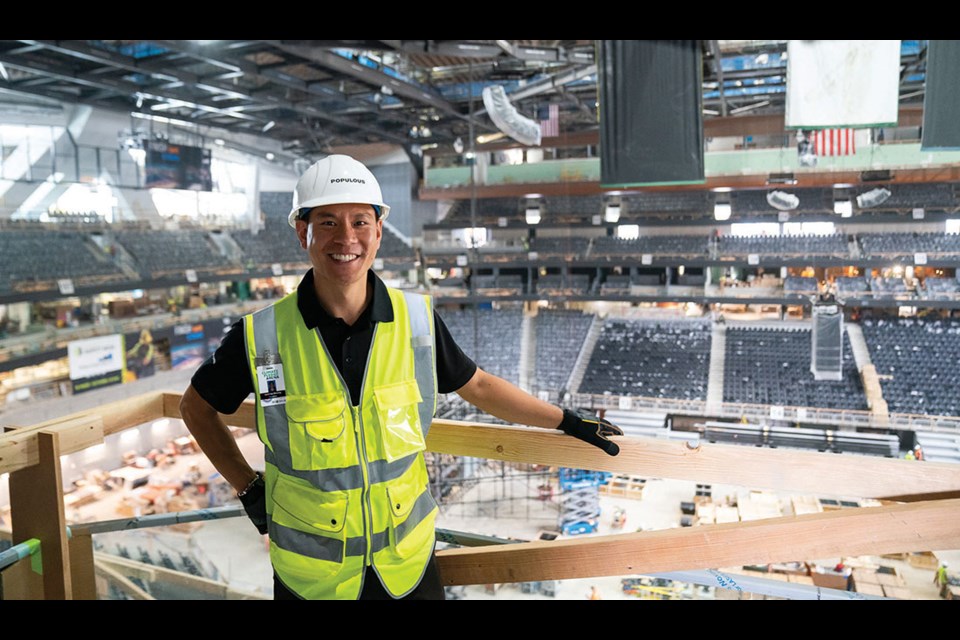It’s the vision and talents of a Delta Secondary graduate that has played a leading role in the home of the NHL’s newest franchise.
When the Seattle Kraken play their first-ever regular season home game at the spectacular Climate Pledge Arena in October against the Vancouver Canucks, Geoff Cheong will quietly be cheering for the visiting team.
The lifelong Canucks fan also happens be lead project designer and principal architect for Populous — a Kansas City based company that specializes in sports facilities and arenas.
Climate Pedge’s opening will culminate four years of his work. T-Mobile Arena (Las Vegas) and Marlins Park (Miami) are among Cheong’s other major venues.
He leads a team of 25 architects and designers on projects that total $1.86 billion over the past 14 years. That also includes transforming stadiums for big single day events such as Super Bowls and NHL Heritage Classics.
“It’s been an absolute blessing landing this opportunity. I couldn’t be more grateful,” said Cheong. “Since joining the firm, the opportunities have just presented themselves. It’s far beyond what I ever could imagined.”
A life changing thesis paper
His life changed forever when he was offered a position with Populous, soon after graduating from BCIT in 2007 with a bachelor's degree in Architectural Science, Diploma of Architectural and Building Engineering Technology.
He initially thought he was headed towards a local career in residential design and even did his internship with a company in West Vancouver, until one of his final major school projects changed his path.
He decided to do his thesis on building an on-campus baseball facility for the UBC Thunderbirds after reading a newspaper article on the Point Grey program’s intentions.
Cheong’s professor encouraged him to reach out to the top sports venue architect firms in North America for potential feedback and guidance.
“I sent out a dozen packages and it was in the mail back then,” laughed Cheong. “I asked if they were willing to spend a few hours sharing their knowledge and expertise with a student here.
"Populous was Called HOK Sport at the time. This firm I was reaching out did all the big stuff, like Yankee Stadium. It was a total long shot but I sent it anyways. It turned out they were the only company that called me back from both countries. Maybe it was meant to be.”
Cheong worked with the company’s minor baseball group on his project and they were impressed enough to offer him a job. He started in the fall of 2007 and months later was already taking on the lead role with the Miami Marlins new ball park.
“The ownership wanted to do something different that no Major League Baseball team had seen before. Not a retro ball park with brick and steel,” continued Cheong. “As a young designer it almost was a perfect fit that I didn’t need to have other experience tied to retro ball parks.”
It all started building with Legos
His interest in building and design came at a young age. He went on to take graphic design courses at DSS and also got involved in building sets for the school’s theatre productions. There was also plenty of sports — playing for Ladner Minor Baseball and Ladner Boys Soccer, with recreational hockey and high school volleyball and badminton too.
“I think my fascination with building structures and that sort of thing came from my childhood playing with Legos. I was a huge Lego fan to the point where my brothers and I sent our home built projects to the Lego magazine and one or two times got something published there. That was exciting for us as kids,” he said.
Cheong recalls telling his family and friends his time with Populous would be short and that he would be back in B.C. in no time. So much has changed from a professional and personal standpoint, including meeting his wife in Missouri. They are expecting their second child in the coming weeks.
He is hoping everything goes well with the arrival of his son and he will be in Seattle on Oct. 23 for Climate Pledge’s grand opening.
Climate Pledge Arena far more than a renovation project
The project is considered a renovation since it’s the original roof of the Seattle Coliseum that was built for the 1962 World’s Fair and later became Key Arena.
It’s anything but according to Cheong.
“It is a completely rebuilt and entirely brand new NHL and NBA capable arena that just happens to sit under that historic 1960s roof that is so cherished by Seattlelites,” he said.
“Certainly that was the challenge, from a design and engineering standpoint — figuring out how on earth to hold (the roof) up and suspend it in mid-air almost while we doubled the square footage of what the previous Key Arena was. Below street level, we have expanded on all sides which has allowed us to design in all the required amenities and program space for a modern arena.
“Those that last saw it as Key Arena, I think their jaws will hit the floor. There will be some going in there thinking it’s a renovation. Now they will understand.”


